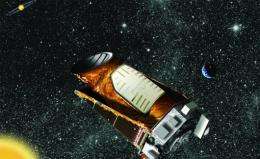NASA gives up fixing Kepler planet-hunting telescope

NASA called off all attempts to fix its crippled Kepler space telescope Thursday. But it's not quite ready to call it quits on the remarkable, robotic planet hunter.
Officials said they're looking at what science, if any, might be salvaged by using the broken spacecraft as is.
The $600 million Kepler mission has been in trouble since May, unable to point with precision at faraway stars in its quest for other potential Earths. That's when a critical second wheel failed on the spacecraft. The first of four gyroscope wheels broke in 2012. At least three are needed for precise pointing.
Since it rocketed into space in 2009, Kepler has confirmed 135 exoplanets—planets outside our solar system. It's also identified more than 3,500 candidate planets.
NASA expects to know by year's end whether the mission is salvageable. Kepler is already on an extended quest; its prime, 3½-year mission ended in November.
The spacecraft is 51 million miles (82 million kilometers) from Earth, orbiting the sun.
If nothing else, new discoveries are expected from data collected over the past four years.
"This is not the last you'll hear from Kepler," promised Paul Hertz, NASA's astrophysics director.
"Kepler has made extraordinary discoveries in finding exoplanets, including several super-Earths in the habitable zone," said John Grunsfeld, a former astronaut who heads NASA's science mission office.
The habitable zone is the distance between a star and planet in which temperatures would permit liquid water and, possibly, life.
"Knowing that Kepler has successfully collected all the data from its prime mission, I am confident that more amazing discoveries are on the horizon," Grunsfeld said in a news release.
Engineers tried without success, over hundreds of hours, to revive the two disabled wheels. The spacecraft remains stable, with thrusters controlling its pointing with as little fuel as possible.
The costs and benefits of the remainder of this mission will be analyzed; results from a pair of studies are expected this autumn, with decisions coming afterward.
Kepler's principal investigator, William Borucki of NASA's Ames Research Center in California, said no one knew at the beginning of Kepler's mission whether Earth-size planets were rare and whether Earthlings might be alone.
"Now at the completion of Kepler observations, we know our galaxy is filled to the brim with planets," Borucki said at a news conference. A large portion of these planets are small like Earth, not gas giants like Jupiter, he noted.
Hundreds, if not thousands, of more exoplanets are expected from Kepler findings, Borucki said. He said it would take another three years to analyze the remaining data.
"We literally expect ... the most exciting discoveries are to come in the next few years as we search through all this data," he said.
© 2013 The Associated Press. All rights reserved.



















